Vietnamese New Year Traditions: A Guide to Celebrate Tet Holiday
Tết or Vietnamese Lunar New Year is the most important event of the country, it’s not just a new year celebration, it’s a time of profound significance, family reunion, and joyous renewal. If you’re curious about Vietnamese New Year traditions, you’ve come to the right place. In this article, we will guide you through the rich tapestry of customs, rituals, and delectable food that make Tết a unique and cherished occasion.
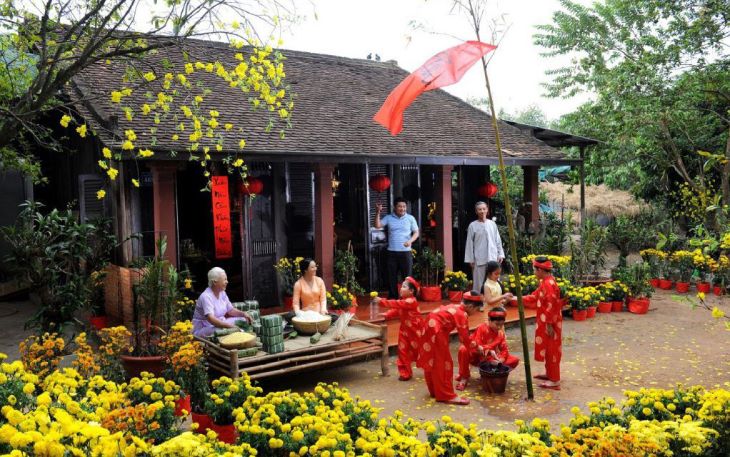
Tết is considered the biggest event of the year in Vietnam. (Image source: Internet)
The Meaning of Tết (Vietnamese New Year)
Tết is way more than just a date on the calendar—it’s the biggest and most important festival in Vietnam. It’s a huge cultural event with deep roots in Vietnamese history and folklore. Think of it as a celebration of spring, a time for fresh starts and new beginnings.
Because it follows the Lunar calendar, Tết usually happens sometime between late January and mid-February. It’s when Vietnamese families get together to give thanks for the past year and look forward to the new one with hope. The Vietnamese New Year traditions are all about family, honoring elders and ancestors, and wishing for good luck.
How Do Vietnamese Prepare for Tết?
Tết is the most important and anticipated event of the year in Vietnam, so thorough preparation is crucial for every Vietnamese family. Preparations typically begin one to two weeks before Tết. The festive atmosphere is palpable everywhere, from the vibrant street decorations to the bustling activity in local markets.
Cleaning The House
This is far more than just a spring cleaning. It’s a ritual cleansing! Every corner of the house is meticulously scrubbed and polished. This tradition symbolizes sweeping away any lingering bad luck or misfortune from the old year, creating space for good fortune to enter the home in the new year.
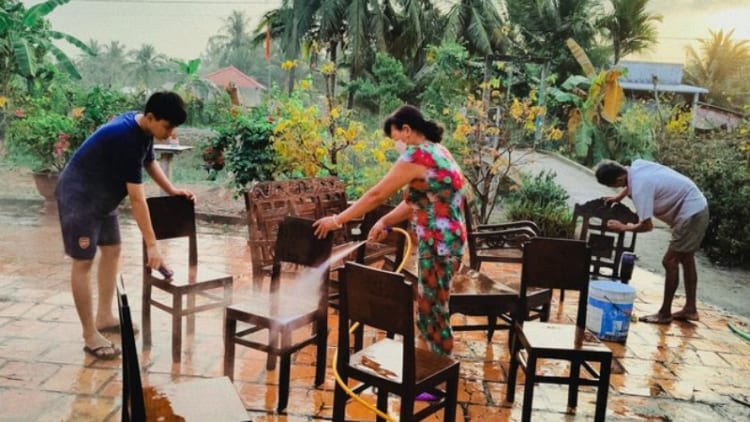
Vietnamese clean their house to welcome the new year with good fortune. (Image source: Internet)
Buying New Clothes
Just as homes are given a fresh start, so are wardrobes. Wearing new and beautiful clothes during Tết is considered auspicious, representing a fresh start and the hope for good luck in the coming year. Children especially look forward to this tradition, eagerly anticipating the new outfits their parents choose for them.
Stocking Up
Because most markets and shops close for several days during Tết, families stock up on essential supplies well in advance. This practical preparation ensures they have everything they need during the holiday period, but it also symbolizes their wishes for a prosperous and abundant new year. Pantries are filled with staples, and freezers are stocked with festive treats.
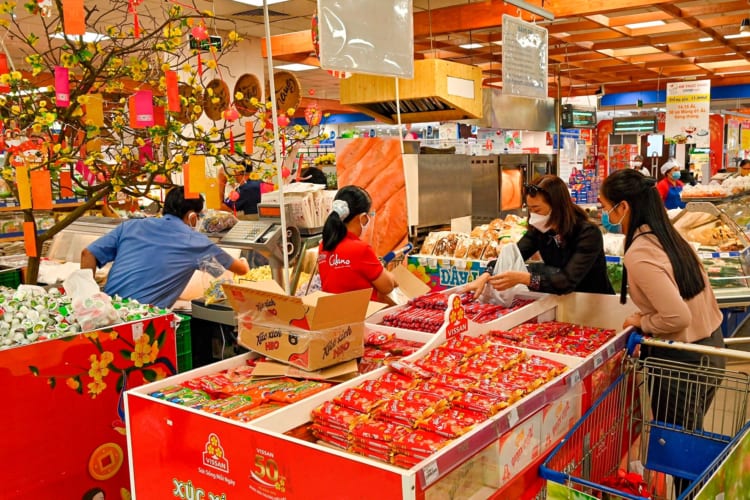
Vietnamese markets are bustling as the Lunar New Year approaches. (Image source: Internet)
Shopping for Decorations & Gifts
Decorating for Tết is a joyous activity, transforming homes into vibrant displays of color and symbolism. Peach blossoms (hoa đào) in the North and apricot blossoms (hoa mai) in the South are iconic symbols of spring, prosperity, and happiness. Red and gold decorations, representing good fortune and wealth, are also prominently featured.
Exchanging gifts and sweets with family and friends is a cherished custom, strengthening bonds and spreading goodwill during this special time.
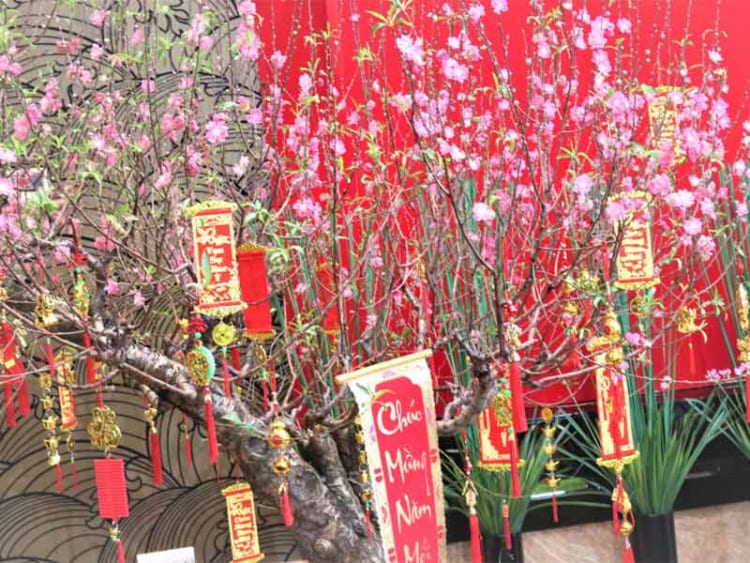
Peach blossoms are displayed throughout Northern Vietnam during the new year. (Image source: Internet)
Wrapping Bánh Chưng or Bánh Tét (Vietnamese Sticky Rice Cake)
Preparing traditional foods like bánh chưng (common in the North) and bánh tét (common in the South) is one of unique Vietnamese New Year traditions. These are indispensable dishes during Tết. During Tết, the kitchen becomes a central gathering place, filled with the enticing aromas of these special dishes. The wrapped cakes are often shared with relatives and close friends.
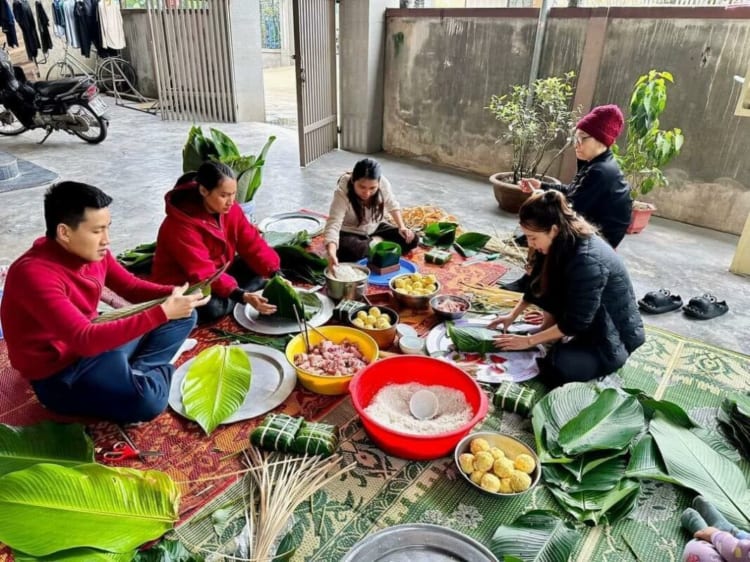
Family members gathering and wrapping bánh chưng for Tết. (Image source: Internet)
Vietnamese New Year Customs and Rituals
Vietnamese New Year traditions are rich with symbolic rituals and customs that have been passed down through generations. These are the things that create the beauty of Tết.
Kitchen Gods (Ông Công, Ông Táo)
About a week before Tết, things get a little spiritual. Families hold a special ceremony to send off the Kitchen Gods—Ông Công and Ông Táo. These aren’t just any old deities, they’re believed to live in every kitchen and keep an eye on the household. Before Tết, they take a trip up to Heaven to give a report to the Jade Emperor. It’s like a cosmic annual performance review!
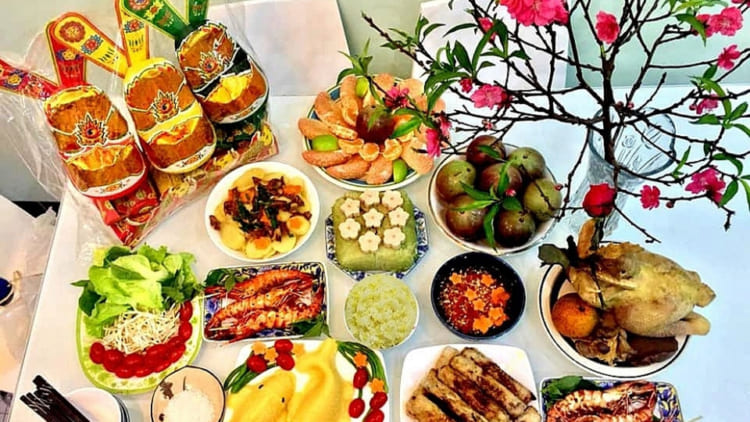
Worshipping the Kitchen Gods is an indispensable tradition during Vietnamese New Year. (Image source: Internet)
New Year’s Eve (Đón Giao Thừa)
New Year’s Eve is a pivotal time, marking the transition from the old year to the new. Families gather for a special meal, a real feast, and often head out to watch spectacular fireworks displays. Many also visit temples to pray for good luck in the coming year. It’s a time of reflection, celebration, and hope.
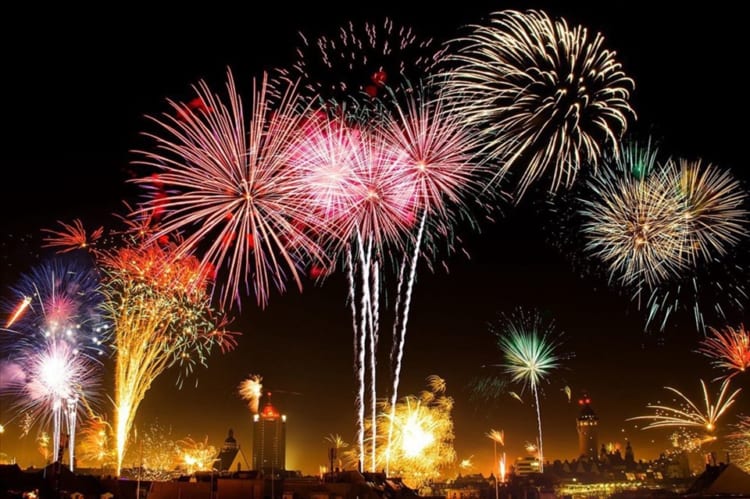
Firework displays on New Year’s Eve. (Image source: Internet)
First Foot (Xông Đất)
This is a really interesting tradition. The very first person to step into your house after midnight on New Year’s Eve is thought to have a big impact on your family’s fortune for the entire year. So, traditionally, families carefully choose someone they believe is lucky, successful, and has a good personality to be the “first footer.”
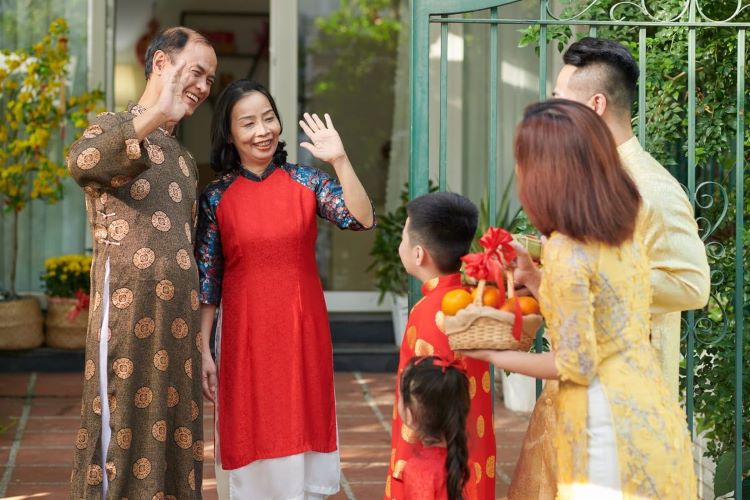
The first footer is believed to have a big impact on your family’s fortune in the new year. (Image source: Internet)
New Year Greetings (Chúc Tết)
Exchanging New Year greetings is a warm and heartfelt tradition. It’s all about wishing each other well for the coming year. You’ll hear phrases like “Chúc Mừng Năm Mới” (Happy New Year), “An Khang Thịnh Vượng” (Prosperity and Health), “Vạn Sự Như Ý” (May all your wishes come true!), “Làm Ăn Tấn Tới” (Be successful at work!) and “Tiền Vô Như Nước” (May money flow in like water!) being shared with smiles and genuine warmth.
>>> Learn a few vietnamese phrases to make your time in Vietnam more fun!
Giving Lucky Money (Lì Xì / Mừng Tuổi)
This is a favorite, especially for kids! Children and elders receive red envelopes containing lucky money (lì xì). The red color symbolizes good luck and warding off evil spirits, and the money is a blessing for prosperity in the new year. It’s a sweet and fun part of Vietnamese New Year traditions.
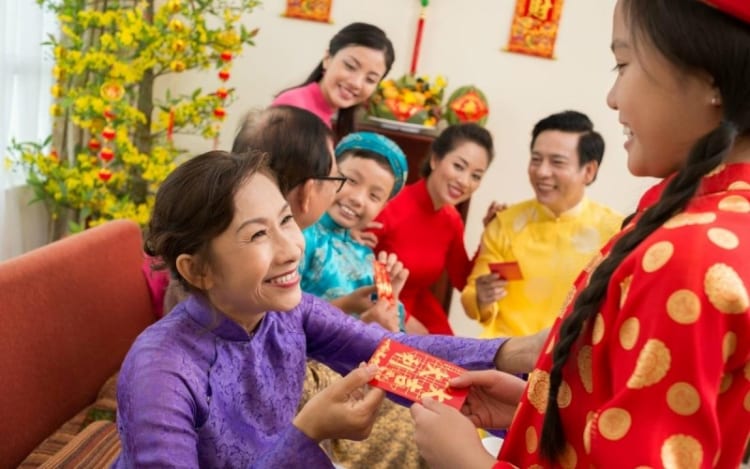
Lì xì (lucky money) is an interesting tradition in Tết, especially for children. (Image source: Internet)
Visiting Relatives and Friends (Thăm Viếng Người Thân)
The first few days of Tết are all about connecting with loved ones. People visit their relatives and friends, exchange greetings, share delicious food, and strengthen those important family and community bonds. It’s a time for laughter, catching up, and enjoying each other’s company.
Visiting Pagodas (Lễ Chùa)
Many Vietnamese people visit pagodas during Tết to pray for good fortune, health, and happiness for themselves and their families. It’s a time for reflection, seeking blessings, and finding peace.
Visiting Ancestral Graves (Tảo Mộ)
This is a deeply meaningful tradition. Families visit the graves of their ancestors to pay respects, clean the gravesites, and invite their ancestors to join in the Tết celebrations. It’s a way of honoring their lineage and remembering those who came before.
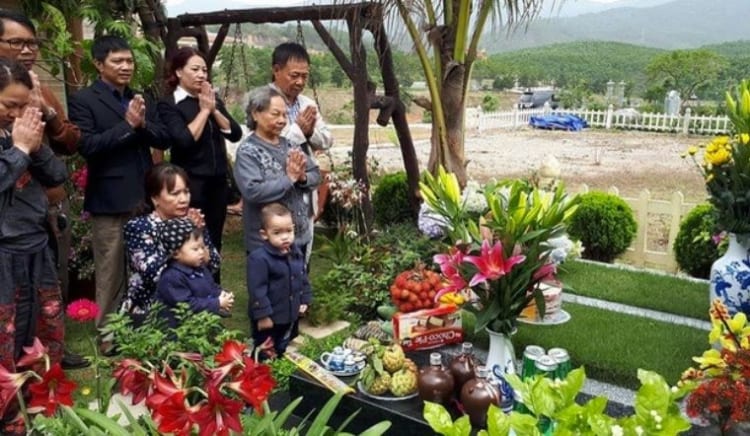
Visiting ancestral graves is a Vietnamese New Year tradition that embodies the principle of remembering one’s origins. (Image source: Internet)
First Departure of the Year (Xuất Hành)
For many, the first trip out of the house in the new year is a significant event. Choosing an auspicious day and time for this “first departure,” whether it’s for business, travel, or just a simple outing, is believed to bring good luck and success in all endeavors throughout the year.
>>> Read more: Vietnam Lunar New Year 2025: Top Destinations to Celebrate
Vietnamese New Year Traditional Foods
When talking about Vietnamese New Year traditions, traditional dishes are indispensable. These dishes are not only appealing but also carry the atmosphere of Tết. Some appear year-round, but there are also some that usually only appear during Tết.
Bánh Chưng and Bánh Tét (Sticky Rice Cakes)
These square (bánh chưng) and cylindrical (bánh tét) sticky rice cakes are iconic Vietnamese New Year foods. They symbolize the earth (bánh chưng) and sky (bánh tét), respectively, and are made with sticky rice, mung beans, and pork belly. Bánh chưng is more prevalent in Northern Vietnam, while bánh tét is more common in the Central and Southern regions. The process of making these cakes, from preparing the ingredients to wrapping and cooking them, is often a time for families to gather and share stories.
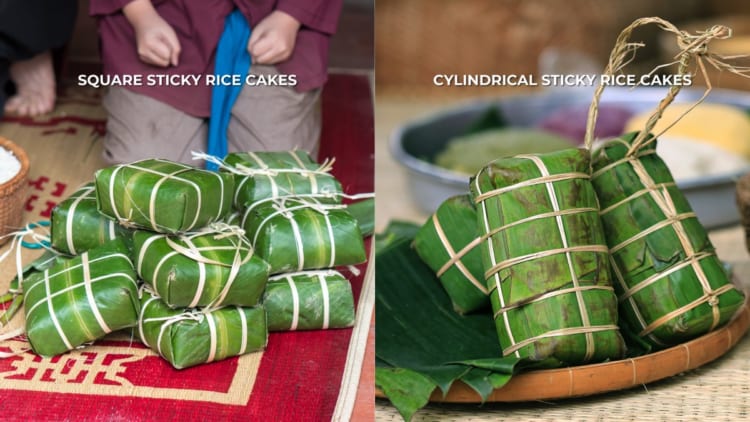
Bánh chưng (left) and bánh tét (right) are indispensable dishes during Vietnamese New Year.
Giò Chả (Vietnamese Sausage)
This savory sausage is made from lean pork and comes in various forms, such as giò lụa (steamed pork sausage) and chả chiên (fried pork sausage). Sausage is often eaten with bánh chưng and bánh tét, or used in salads. Giò thủ (head cheese) is another popular variety often seen during Tết.
Thịt Kho Hột Vịt (Braised Pork with Eggs)
Thịt kho hột vịt is a familiar and beloved dish in Vietnamese family meals, especially during Tết. Pork belly is braised until tender with duck eggs and coconut water, creating a rich, savory-sweet, and fatty flavor. This dish symbolizes warmth, prosperity, and family togetherness.
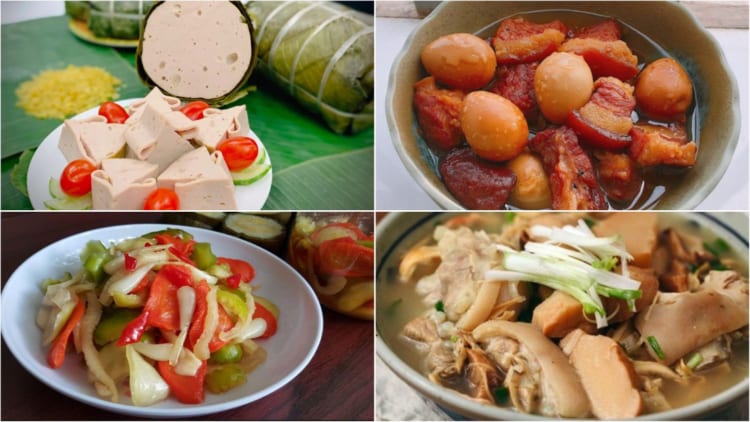
Common dishes during Vietnamese New Year.
Dưa Món (Pickled Vegetables)
Dưa món is an indispensable side dish on the Tết feast table. Various vegetables such as carrots, white radishes, and papaya are pickled in a sweet and sour brine. This helps balance the rich flavors of other dishes, especially those that are oily or fatty.
Canh Măng (Bamboo Shoot Soup)
This flavorful soup, made with dried bamboo shoots and pork or chicken, is a staple on Tết tables. Canh măng has the subtle sweetness of bamboo shoots and the rich flavor of the broth. It is often cooked with pork knuckles or ribs.
Vietnamese New Year Traditional Decorations
Vietnamese New Year traditions are visually stunning, with vibrant decorations adorning homes and streets. These decorations aren’t just pretty, they’re rich with symbolism and meaning, adding depth to the festive atmosphere.
Hoa Đào (Peach Blossoms) and Hoa Mai (Apricot Blossoms)
These delicate blossoms are quintessential symbols of Tết, representing renewal, prosperity, and good luck. The soft pink of peach blossoms (hoa đào) is more commonly seen in the cooler climate of Northern Vietnam, while the vibrant yellow of apricot blossoms (hoa mai) is favored in the warmer South. Seeing these blossoms in full bloom is a sure sign that spring has arrived and Tết is just around the corner. They bring a touch of natural beauty and optimism to every home.
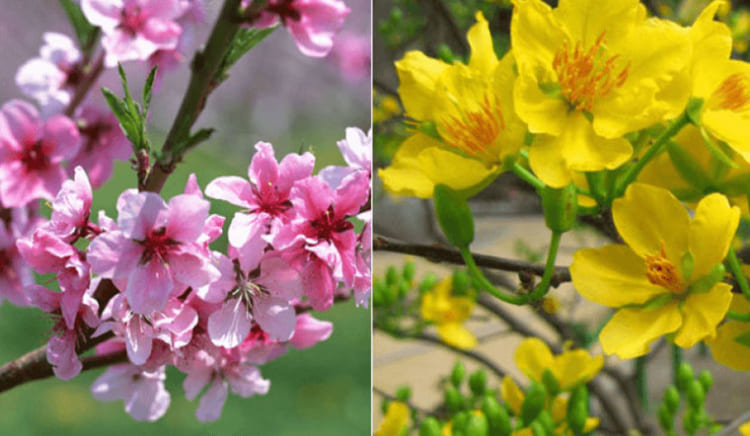
Peach blossoms (left) and apricot blossoms (right). (Image source: Internet)
Cây Nêu (New Year Pole)
This tall bamboo pole, a striking feature of Tết, is erected in front of houses to ward off evil spirits and welcome good fortune. Traditionally, the top of the cây nêu is adorned with various symbolic items, such as a small red flag, a bell, and sometimes even a bundle of straw. These items vary by region, but they all serve the purpose of protecting the home and bringing good luck in the new year. The raising of the cây nêu is a significant ritual, marking the official start of the Tết festivities in some areas.
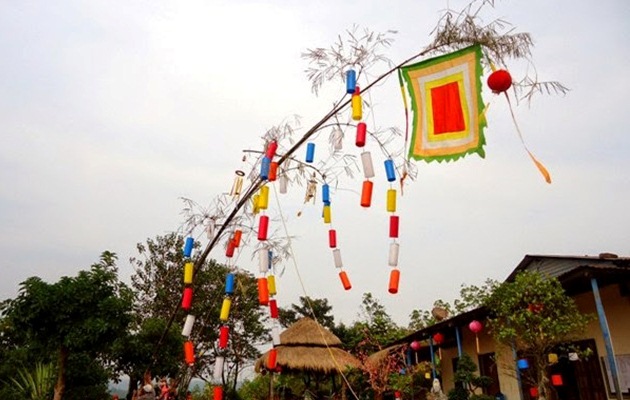
Cây nêu is believed to protect the home and bring good luck in the new year. (Image source: Internet)
Câu Đối (Parallel Sentences/Antithetical Couplets)
These beautifully written poetic couplets, known as câu đối, are an integral part of Tết decorations. Written in parallel structure with matching tones and meanings, they express wishes for the new year, such as good health, prosperity, and happiness. These couplets are typically written in black ink on bright red banners, creating a striking contrast and adding a touch of traditional elegance to homes and public spaces. They are often displayed on either side of doorways or altars.
Tết or Vietnamese New Year traditions showcase the rich cultural heritage of Vietnam. It is a time for reflection, renewal, and celebration, bringing families and communities together. Whether it’s the meticulous cleaning of the house, the sharing of traditional food, or the exchange of warm greetings, every aspect of Tết is imbued with meaning and symbolism. So, make sure you don’t miss this unique event in your next Vietnam tour!
>>> Tour you may like: SECRET VIETNAM FROM THE NORTH TO SOUTH

